Abstract
1. The isolated perfused rat mesenteric arterial bed was used to examine the activity of the adenine dinucleotides: beta-nicotinamide adenine dinucleotide (NAD); beta-nicotinamide adenine dinucleotide phosphate (NADP); flavin adenine dinucleotide (FAD); and of the alpha,omega-diadenosine polyphosphates: adenylyl adenosine (AP1A); P1,P2-diadenosine pyrophosphate (AP2A); P1,P3-diadenosine triphosphate (AP3A); P1,P4-diadenosine tetraphosphate (AP4A); P1,P5-diadenosine pentaphosphate (AP5A); P1,P6-diadenosine hexaphosphate (AP6A). Responses were compared with those of ADP, ATP, 2-methylthio-ATP (2-meSATP) and alpha,beta-methylene ATP (alpha,beta-meATP). 2. In basal tone preparations mono- and dinucleotides elicited vasoconstriction with the order of potency: alpha,beta-meATP > or = AP5A > or = AP6A > or = AP4A > or = 2-meSATP >> ATP >> ADP. The dinucleotides NAD, NADP, FAD, AP1A, AP2A and AP3A had no effect. 3. The P2X-purinoceptor antagonist pyridoxalphosphate-6-azophenyl-2',4'-disulphonic acid (30 microM) virtually abolished vasoconstrictor responses to AP4A, AP5A and AP6A. 4. Auto- and cross-desensitization of vasoconstrictor responses to AP4A, AP5A, AP6A, ATP and alpha,beta-meATP were observed. 5. In raised tone preparations nucleotides elicited endothelium-dependent vasodilatation with the order of potency: 2-meSATP = ADP > ATP > AP3A > AP2A > AP1A = NADP = FAD > NAD. The nucleotides AP4A, AP5A, AP6A and alpha,beta-meATP had no vasodilator effects. 6. It is concluded that the alpha,omega-adenine dinucleotides AP4A, AP5A and AP6A elicit vasoconstriction, but not vasodilatation, in the rat mesenteric arterial bed via P2x-purinoceptors. In contrast, the dinucleotides NADP, FAD, AP1A, AP2A and AP3A elicit vasodilatation, but not vasoconstriction, via endothelial P2Y-purinoceptors. 7. It is suggested that there is a crucial relationship between the structure of the alpha,omega-diadenosine polyphosphates and their activity at P2X- and P2Y-purinoceptors with a pivotal role played by the polyphosphate chain. Molecules with four or more phosphates are vasoconstrictors, while those with three or less phosphates are vasodilators.
Full text
PDF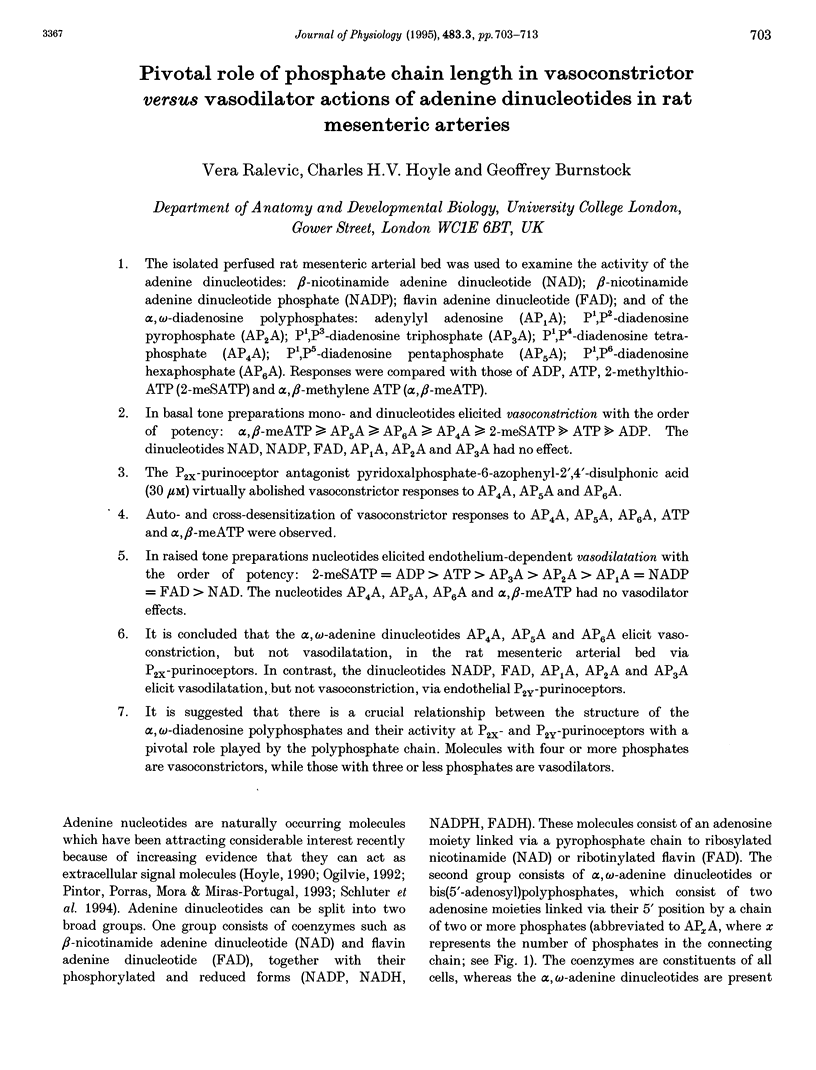
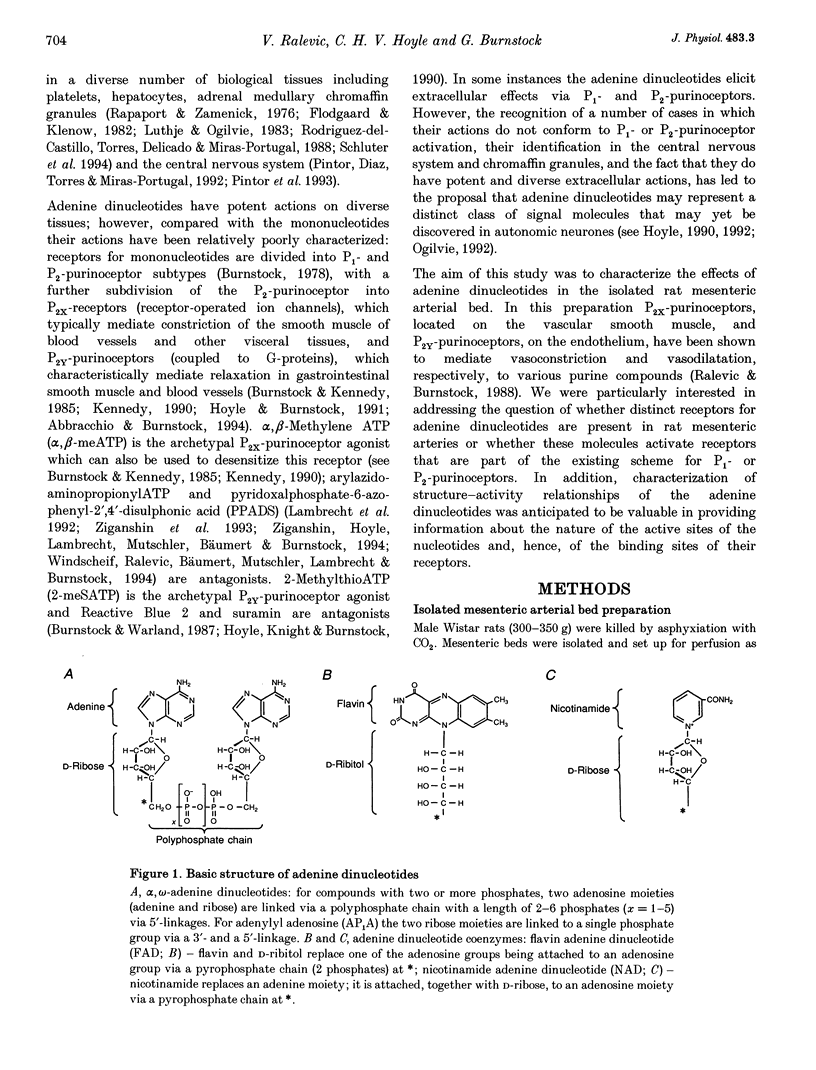
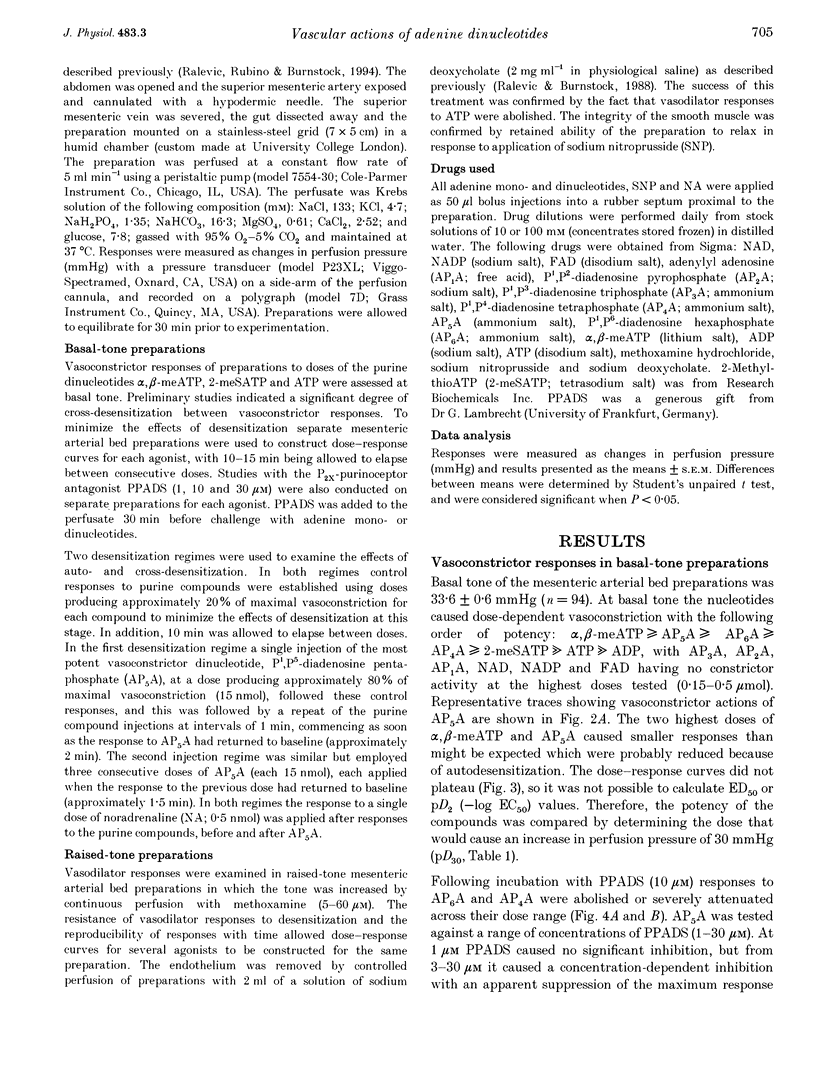
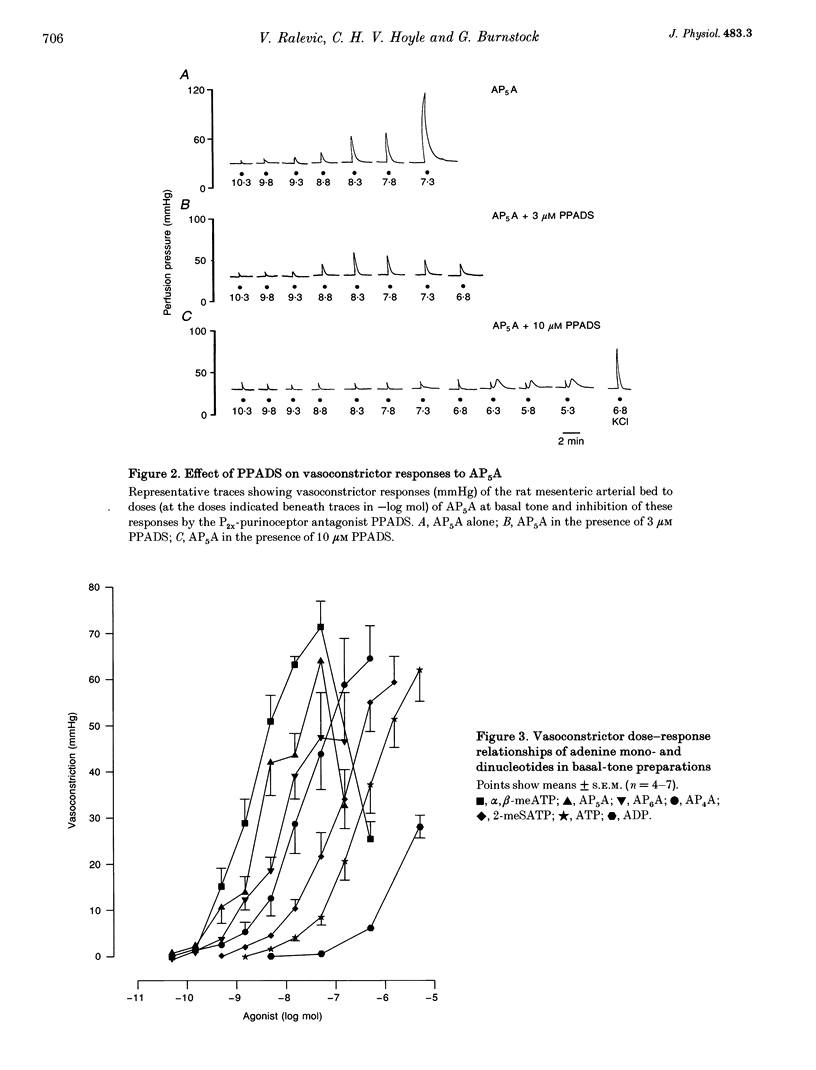
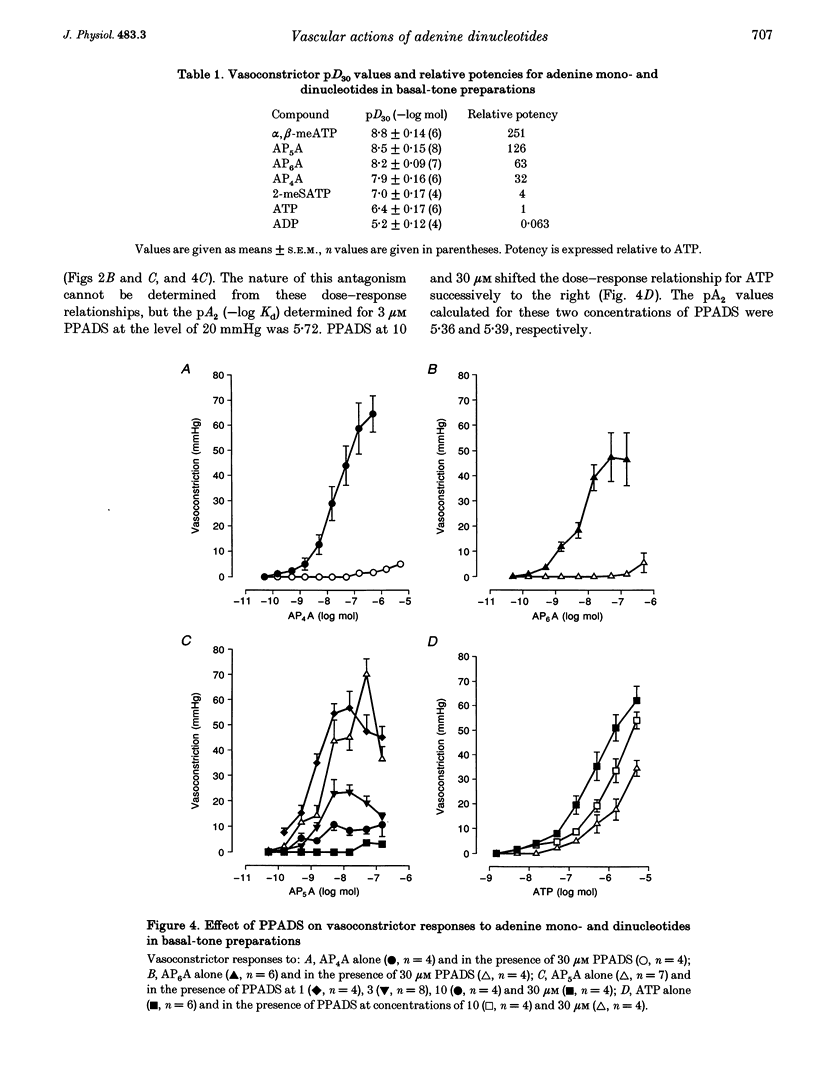
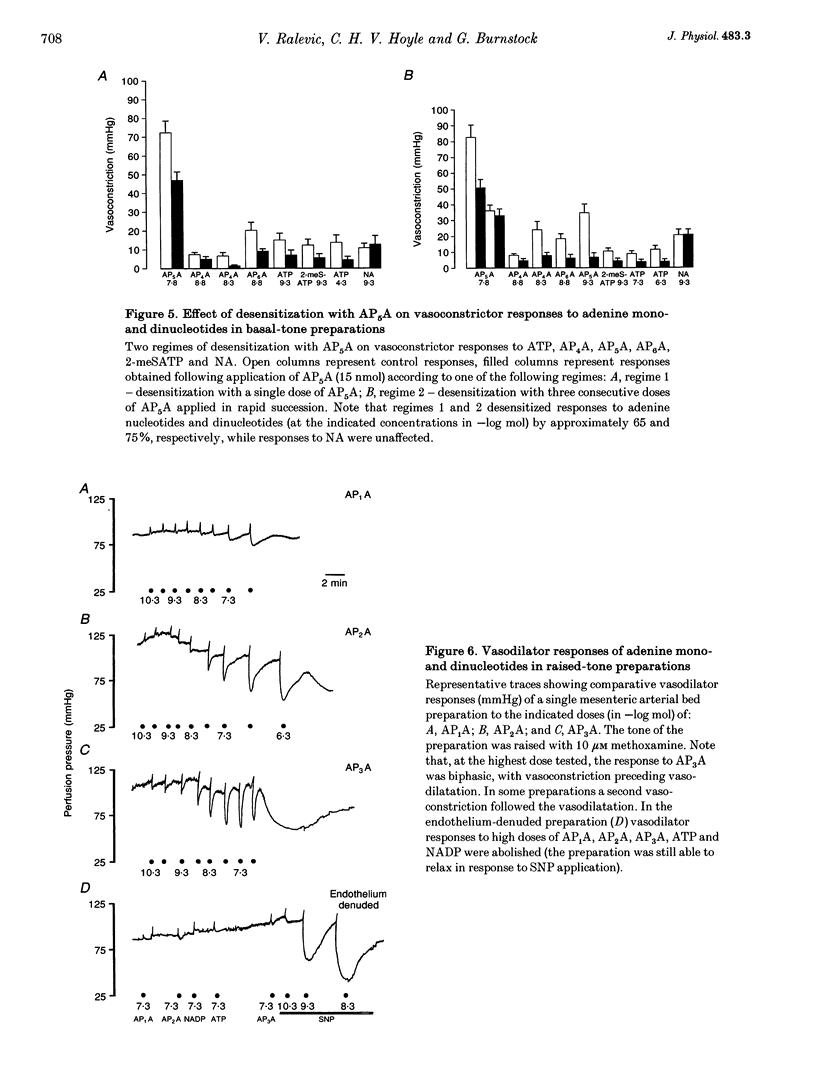
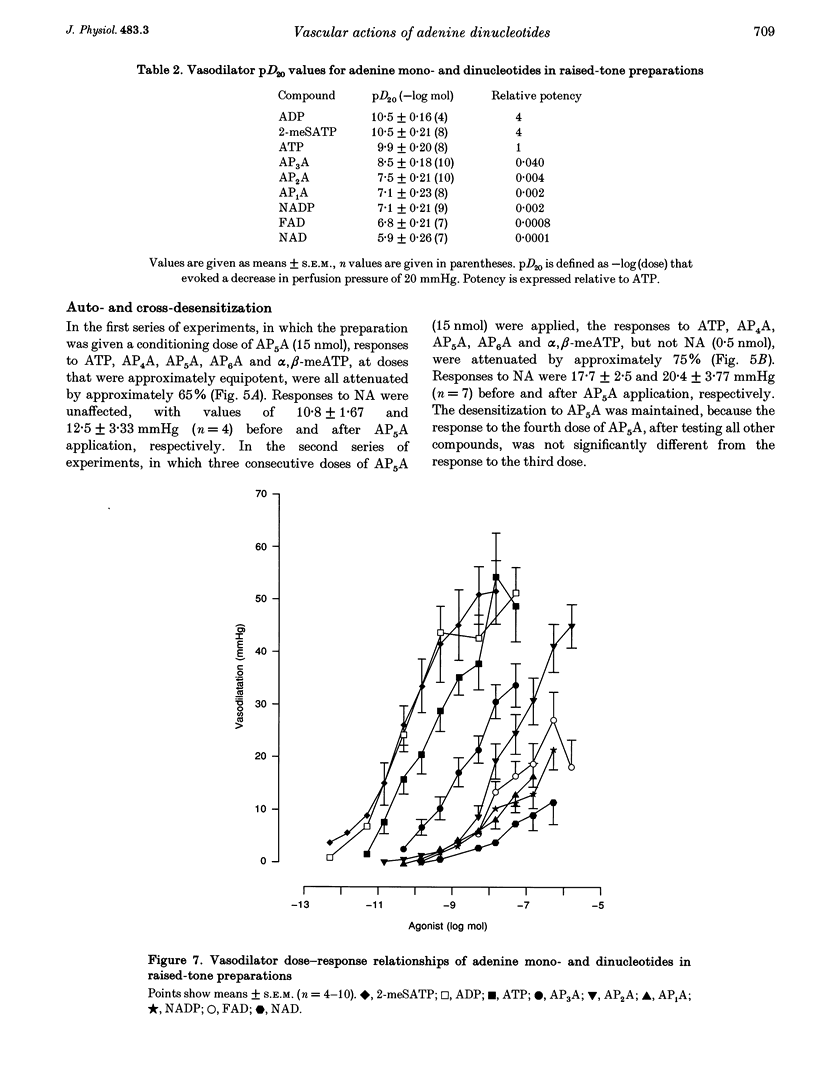
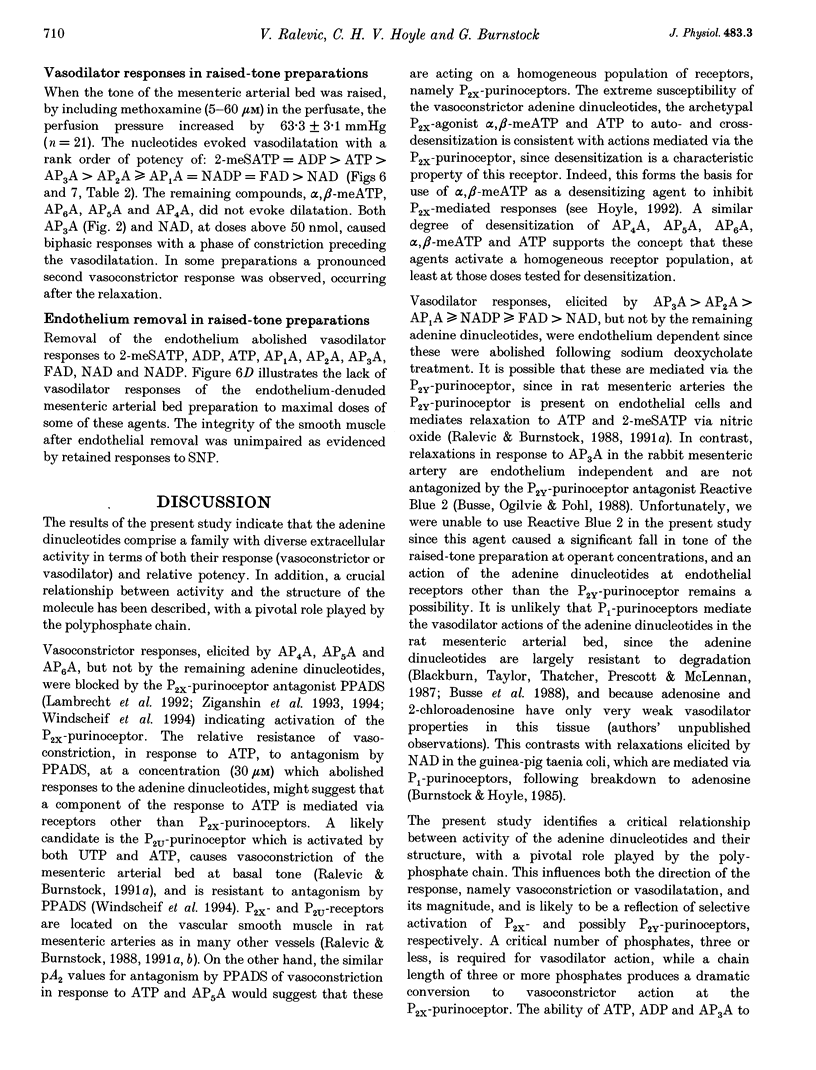
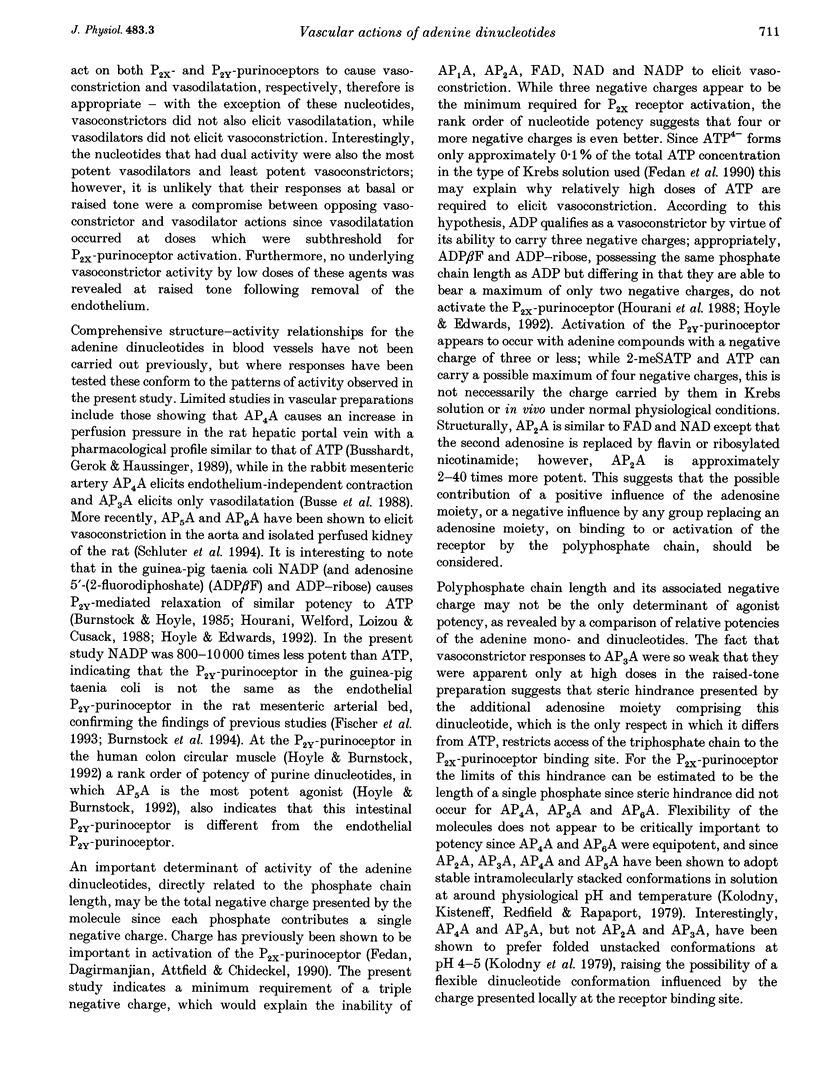
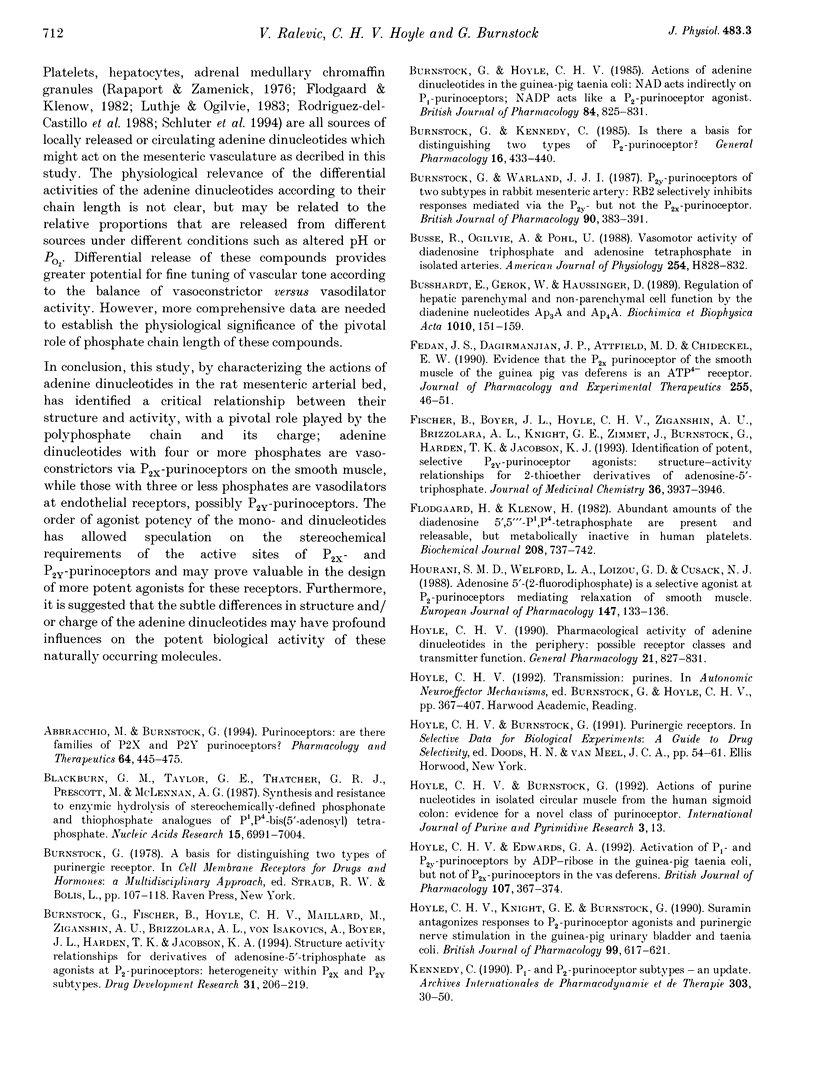
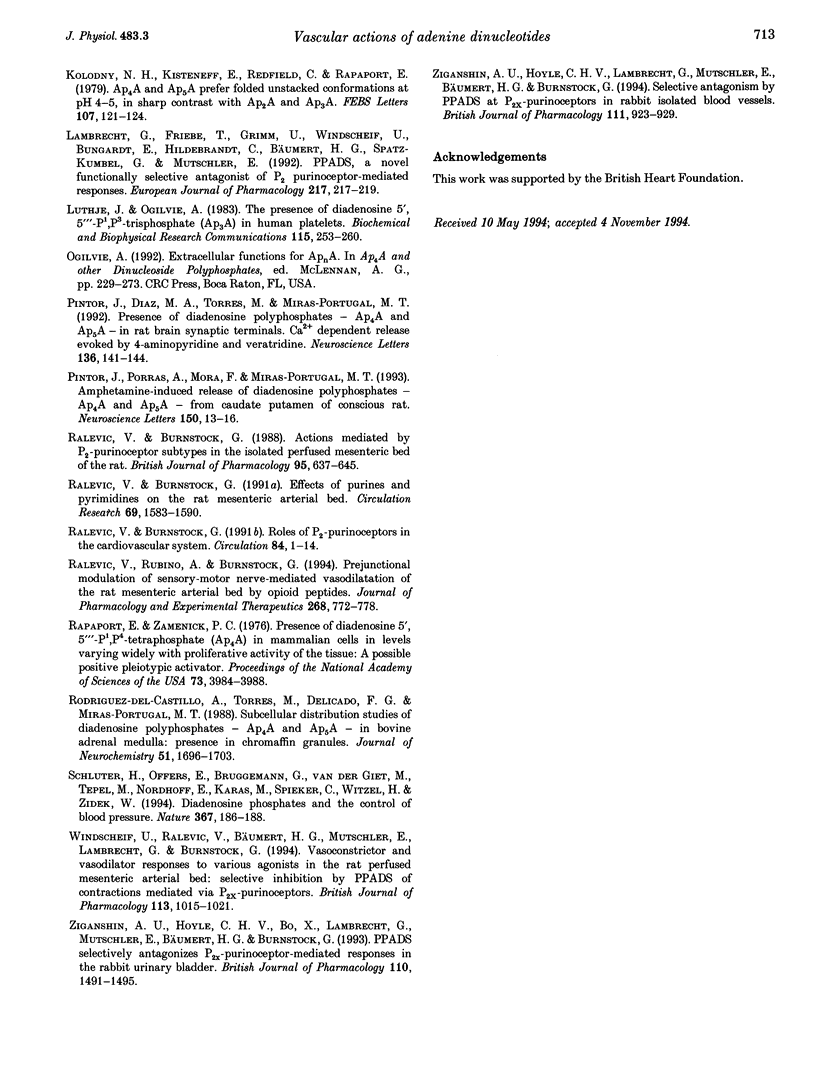
Selected References
These references are in PubMed. This may not be the complete list of references from this article.
- Abbracchio M. P., Burnstock G. Purinoceptors: are there families of P2X and P2Y purinoceptors? Pharmacol Ther. 1994;64(3):445–475. doi: 10.1016/0163-7258(94)00048-4. [DOI] [PubMed] [Google Scholar]
- Blackburn G. M., Taylor G. E., Thatcher G. R., Prescott M., McLennan A. G. Synthesis and resistance to enzymic hydrolysis of stereochemically-defined phosphonate and thiophosphate analogues of P1,P4-bis(5'-adenosyl) tetraphosphate. Nucleic Acids Res. 1987 Sep 11;15(17):6991–7004. doi: 10.1093/nar/15.17.6991. [DOI] [PMC free article] [PubMed] [Google Scholar]
- Burnstock G., Hoyle C. H. Actions of adenine dinucleotides in the guinea-pig taenia coli: NAD acts indirectly on P1-purinoceptors; NADP acts like a P2-purinoceptor agonist. Br J Pharmacol. 1985 Apr;84(4):825–831. doi: 10.1111/j.1476-5381.1985.tb17376.x. [DOI] [PMC free article] [PubMed] [Google Scholar]
- Burnstock G., Kennedy C. Is there a basis for distinguishing two types of P2-purinoceptor? Gen Pharmacol. 1985;16(5):433–440. doi: 10.1016/0306-3623(85)90001-1. [DOI] [PubMed] [Google Scholar]
- Burnstock G., Warland J. J. P2-purinoceptors of two subtypes in the rabbit mesenteric artery: reactive blue 2 selectively inhibits responses mediated via the P2y-but not the P2x-purinoceptor. Br J Pharmacol. 1987 Feb;90(2):383–391. doi: 10.1111/j.1476-5381.1987.tb08968.x. [DOI] [PMC free article] [PubMed] [Google Scholar]
- Busse R., Ogilvie A., Pohl U. Vasomotor activity of diadenosine triphosphate and diadenosine tetraphosphate in isolated arteries. Am J Physiol. 1988 May;254(5 Pt 2):H828–H832. doi: 10.1152/ajpheart.1988.254.5.H828. [DOI] [PubMed] [Google Scholar]
- Busshardt E., Gerok W., Häussinger D. Regulation of hepatic parenchymal and non-parenchymal cell function by the diadenine nucleotides Ap3A and Ap4A. Biochim Biophys Acta. 1989 Feb 9;1010(2):151–159. doi: 10.1016/0167-4889(89)90155-9. [DOI] [PubMed] [Google Scholar]
- Fedan J. S., Dagirmanjian J. P., Attfield M. D., Chideckel E. W. Evidence that the P2x purinoceptor of the smooth muscle of the guinea pig vas deferens is an ATP4- receptor. J Pharmacol Exp Ther. 1990 Oct;255(1):46–51. [PubMed] [Google Scholar]
- Fischer B., Boyer J. L., Hoyle C. H., Ziganshin A. U., Brizzolara A. L., Knight G. E., Zimmet J., Burnstock G., Harden T. K., Jacobson K. A. Identification of potent, selective P2Y-purinoceptor agonists: structure-activity relationships for 2-thioether derivatives of adenosine 5'-triphosphate. J Med Chem. 1993 Nov 26;36(24):3937–3946. doi: 10.1021/jm00076a023. [DOI] [PMC free article] [PubMed] [Google Scholar]
- Flodgaard H., Klenow H. Abundant amounts of diadenosine 5',5"'-P1,P4-tetraphosphate are present and releasable, but metabolically inactive, in human platelets. Biochem J. 1982 Dec 15;208(3):737–742. doi: 10.1042/bj2080737. [DOI] [PMC free article] [PubMed] [Google Scholar]
- Hourani S. M., Welford L. A., Loizou G. D., Cusak N. J. Adenosine 5'-(2-fluorodiphosphate) is a selective agonist at P2-purinoceptors mediating relaxation of smooth muscle. Eur J Pharmacol. 1988 Feb 16;147(1):131–136. doi: 10.1016/0014-2999(88)90642-5. [DOI] [PubMed] [Google Scholar]
- Hoyle C. H., Edwards G. A. Activation of P1- and P2Y-purinoceptors by ADP-ribose in the guinea-pig taenia coli, but not of P2X-purinoceptors in the vas deferens. Br J Pharmacol. 1992 Oct;107(2):367–374. doi: 10.1111/j.1476-5381.1992.tb12753.x. [DOI] [PMC free article] [PubMed] [Google Scholar]
- Hoyle C. H., Knight G. E., Burnstock G. Suramin antagonizes responses to P2-purinoceptor agonists and purinergic nerve stimulation in the guinea-pig urinary bladder and taenia coli. Br J Pharmacol. 1990 Mar;99(3):617–621. doi: 10.1111/j.1476-5381.1990.tb12979.x. [DOI] [PMC free article] [PubMed] [Google Scholar]
- Hoyle C. H. Pharmacological activity of adenine dinucleotides in the periphery: possible receptor classes and transmitter function. Gen Pharmacol. 1990;21(6):827–831. doi: 10.1016/0306-3623(90)90440-w. [DOI] [PubMed] [Google Scholar]
- Kennedy C. P1- and P2-purinoceptor subtypes--an update. Arch Int Pharmacodyn Ther. 1990 Jan-Feb;303:30–50. [PubMed] [Google Scholar]
- Kolodny N. H., Kisteneff E., Redfield C., Rapaport E. Ap4A and Ap5A prefer folded unstacked conformations at pH 4-5, in sharp contrast with Ap2A and Ap3A. FEBS Lett. 1979 Nov 1;107(1):121–124. doi: 10.1016/0014-5793(79)80477-9. [DOI] [PubMed] [Google Scholar]
- Lambrecht G., Friebe T., Grimm U., Windscheif U., Bungardt E., Hildebrandt C., Bäumert H. G., Spatz-Kümbel G., Mutschler E. PPADS, a novel functionally selective antagonist of P2 purinoceptor-mediated responses. Eur J Pharmacol. 1992 Jul 7;217(2-3):217–219. doi: 10.1016/0014-2999(92)90877-7. [DOI] [PubMed] [Google Scholar]
- Lüthje J., Ogilvie A. The presence of diadenosine 5',5'''-P1,P3-triphosphate (Ap3A) in human platelets. Biochem Biophys Res Commun. 1983 Aug 30;115(1):253–260. doi: 10.1016/0006-291x(83)90997-x. [DOI] [PubMed] [Google Scholar]
- Pintor J., Díaz-Rey M. A., Torres M., Miras-Portugal M. T. Presence of diadenosine polyphosphates--Ap4A and Ap5A--in rat brain synaptic terminals. Ca2+ dependent release evoked by 4-aminopyridine and veratridine. Neurosci Lett. 1992 Mar 2;136(2):141–144. doi: 10.1016/0304-3940(92)90034-5. [DOI] [PubMed] [Google Scholar]
- Pintor J., Porras A., Mora F., Miras-Portugal M. T. Amphetamine-induced release of diadenosine polyphosphates--Ap4A and Ap5A--from caudate putamen of conscious rat. Neurosci Lett. 1993 Feb 5;150(1):13–16. doi: 10.1016/0304-3940(93)90096-4. [DOI] [PubMed] [Google Scholar]
- Ralevic V., Burnstock G. Actions mediated by P2-purinoceptor subtypes in the isolated perfused mesenteric bed of the rat. Br J Pharmacol. 1988 Oct;95(2):637–645. doi: 10.1111/j.1476-5381.1988.tb11686.x. [DOI] [PMC free article] [PubMed] [Google Scholar]
- Ralevic V., Burnstock G. Effects of purines and pyrimidines on the rat mesenteric arterial bed. Circ Res. 1991 Dec;69(6):1583–1590. doi: 10.1161/01.res.69.6.1583. [DOI] [PubMed] [Google Scholar]
- Ralevic V., Burnstock G. Roles of P2-purinoceptors in the cardiovascular system. Circulation. 1991 Jul;84(1):1–14. doi: 10.1161/01.cir.84.1.1. [DOI] [PubMed] [Google Scholar]
- Ralevic V., Rubino A., Burnstock G. Prejunctional modulation of sensory-motor nerve-mediated vasodilatation of the rat mesenteric arterial bed by opioid peptides. J Pharmacol Exp Ther. 1994 Feb;268(2):772–778. [PubMed] [Google Scholar]
- Rapaport E., Zamecnik P. C. Presence of diadenosine 5',5''' -P1, P4-tetraphosphate (Ap4A) in mamalian cells in levels varying widely with proliferative activity of the tissue: a possible positive "pleiotypic activator". Proc Natl Acad Sci U S A. 1976 Nov;73(11):3984–3988. doi: 10.1073/pnas.73.11.3984. [DOI] [PMC free article] [PubMed] [Google Scholar]
- Rodriguez del Castillo A., Torres M., Delicado E. G., Miras-Portugal M. T. Subcellular distribution studies of diadenosine polyphosphates--Ap4A and Ap5A--in bovine adrenal medulla: presence in chromaffin granules. J Neurochem. 1988 Dec;51(6):1696–1703. doi: 10.1111/j.1471-4159.1988.tb01147.x. [DOI] [PubMed] [Google Scholar]
- Schlüter H., Offers E., Brüggemann G., van der Giet M., Tepel M., Nordhoff E., Karas M., Spieker C., Witzel H., Zidek W. Diadenosine phosphates and the physiological control of blood pressure. Nature. 1994 Jan 13;367(6459):186–188. doi: 10.1038/367186a0. [DOI] [PubMed] [Google Scholar]
- Windscheif U., Ralevic V., Bäumert H. G., Mutschler E., Lambrecht G., Burnstock G. Vasoconstrictor and vasodilator responses to various agonists in the rat perfused mesenteric arterial bed: selective inhibition by PPADS of contractions mediated via P2x-purinoceptors. Br J Pharmacol. 1994 Nov;113(3):1015–1021. doi: 10.1111/j.1476-5381.1994.tb17094.x. [DOI] [PMC free article] [PubMed] [Google Scholar]
- Ziganshin A. U., Hoyle C. H., Bo X., Lambrecht G., Mutschler E., Bäumert H. G., Burnstock G. PPADS selectively antagonizes P2X-purinoceptor-mediated responses in the rabbit urinary bladder. Br J Pharmacol. 1993 Dec;110(4):1491–1495. doi: 10.1111/j.1476-5381.1993.tb13990.x. [DOI] [PMC free article] [PubMed] [Google Scholar]
- Ziganshin A. U., Hoyle C. H., Lambrecht G., Mutschler E., Bümert H. G., Burnstock G. Selective antagonism by PPADS at P2X-purinoceptors in rabbit isolated blood vessels. Br J Pharmacol. 1994 Mar;111(3):923–929. doi: 10.1111/j.1476-5381.1994.tb14827.x. [DOI] [PMC free article] [PubMed] [Google Scholar]


